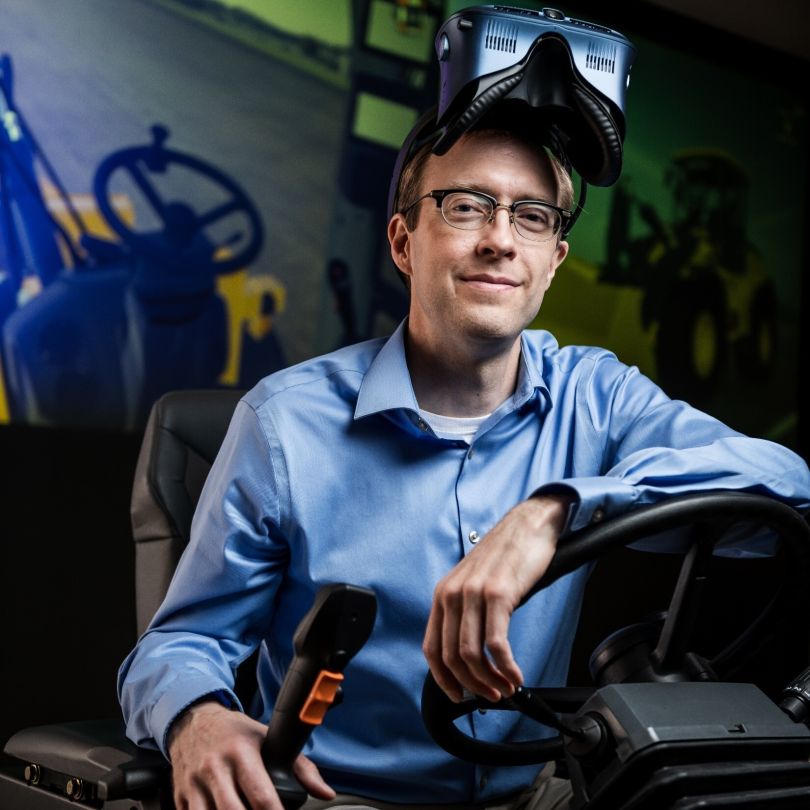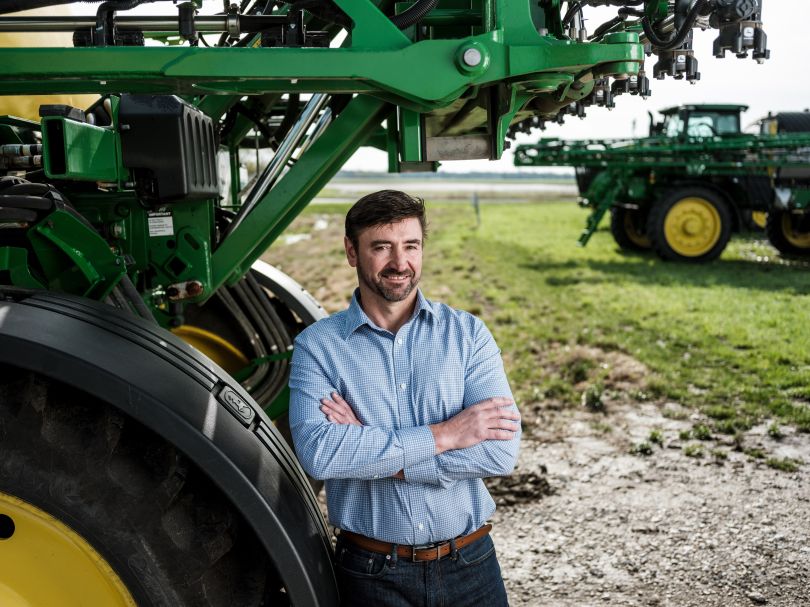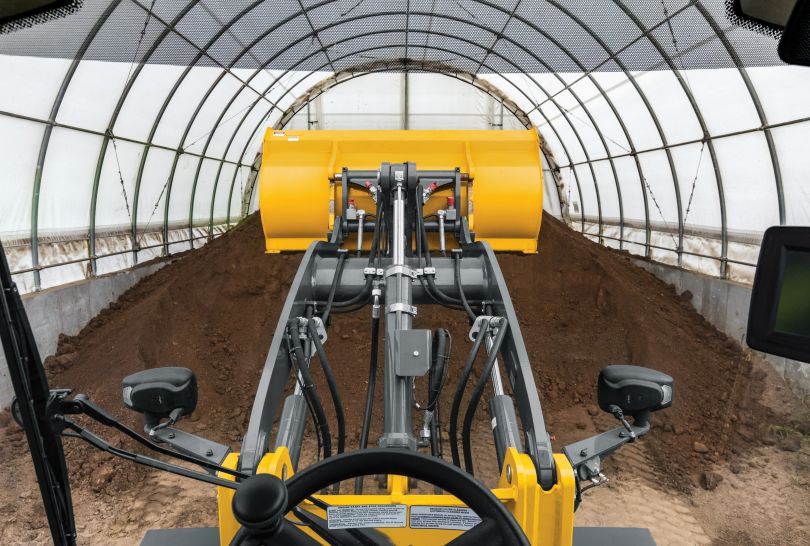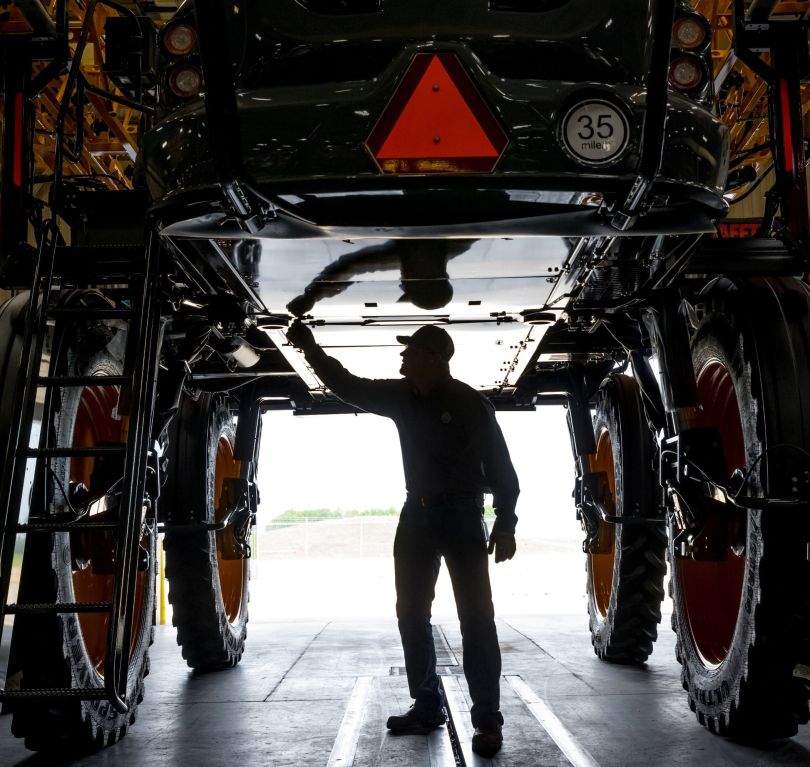Kurt Chipperfield knows he has done his job well when a customer tries to lean against a nonexistent tractor.
At John Deere’s virtual reality lab in Dubuque, Iowa, the staff engineer walks customers through the company’s emerging product line, augmented by VR headsets. The products they see, from forestry forwarders to skid steers, seem real, bedecked with controls and tires that appear close enough to touch — yet each one is a matter of virtual computing.
“It’s magical how the conversation changes from, ‘Here’s this weird headset I’m wearing,’ to ‘These are the features that are important to me,’” Chipperfield said.
The work Chipperfield accomplishes, which he considers suspension of disbelief in its purest form, has enabled the company to tackle the product design process more quickly and easily. Given this impact, Chipperfield received the John Deere Advanced Visualization Fellow Award in 2022.

Chipperfield is one of many individuals who have been awarded through the John Deere Fellows Program, an initiative that recognizes employees who have contributed to the company’s success. Through their achievements in digital technology and manufacturing, fellows help shape an innovative, more sustainable future for the organization.
Every fellow plays a unique role in driving this influence, and in some cases, that impact is built over many years. Application Technology Lead Rich Humpal knows the long journey to success well, having spent the past two decades of his career refining John Deere’s application systems.

The Application Technology Fellow has learned what it takes to tackle complex challenges over the years, and one of the biggest lessons he has learned is to adopt an “inside-the-box” mentality, relying heavily on internal knowledge from peers.
“Everybody has their own expertise in their area,” he said. “I like to reach out and pull these people in and expand my knowledge.”
Expertise takes many forms at John Deere, promulgated by individuals who are passionate about their respective fields. This passion is what brought Goutam Mohapatra to the company, where he works as a staff engineer in materials analytics and integrated computational materials engineering.
Mohapatra’s knowledge of machine learning and AI hasn’t just earned him the title of Materials Engineering Analytics Fellow; it has spawned the creation of solutions that have benefited countless customers across the globe.
In their own unique way, Chipperfield, Humpal and Mohapatra drive John Deere’s commitment to elevating its impact on the world by pursuing cutting-edge work and inspiring others to join in fueling change.
Inspiring Others to ‘Ride the Bull’
For Chipperfield, working at John Deere feels a bit like riding a bull.
Having gone to rodeos while growing up in Kansas, he knows a thing or two about how bull-riding scores work: “Part of your score is staying on the bull, but the other part of your score is simply the bull. If you get a wild one, you get a better score.”
At John Deere, Chipperfield explained, the situation is similar. Sometimes, a project is assessed based on the opportunities and challenges associated with it, while other times, it’s evaluated by its innate complexity and the ways in which team members handle these intricacies.
In the company’s VR lab, Chipperfield makes the most of the projects put in front of him, seeing each one as a new chance to learn by unraveling complex issues. He believes this focus on solving challenges defines his team’s approach to VR, driving his motivation to mentor both colleagues and people outside of the company.
When he’s not diving into a new technology, Chipperfield enjoys supporting STEM programs at local schools, which allows him to share his passion for technology with younger generations.
“STEM is trying to get younger people interested in engineering, and VR is great for that, because it kind of shows them a fun and cool side of engineering,” he said. “You don’t just sit at a desk all day — you interact with customers, drive tractors, solve problems and do cool stuff.”
This enthusiasm for innovation has carried Chipperfield far in his career at John Deere. Besides integrating 3D printing support, which increased prototype demand six-fold in seven years, he also created a virtual garage that builds 3D models for VR, product support and marketing.
Despite the leading role he played in these achievements, Chipperfield doesn’t see any of it as a personal success story. In his mind, these accomplishments were only made possible by his peers.
“I haven’t been alone on this journey,” he said. “A lot of the credit, even for the things that I’ve done, goes to other people I’ve worked with. This really is like a family.”
“This really is like a family.”

The Power of a Can-Do Attitude
There’s nothing as formative as family, whether that pertains to individuals we’ve bonded with over time or those we’ve known since birth.
For Humpal, this latter definition of family has had a lasting impact on him and his professional journey. As a child, his parents taught him many valuable lessons, such as the importance of having a positive attitude when it comes to resolving issues.
“‘Can’t’ wasn’t a word we were allowed to use,” Humpal recalled.
But among the many life principles his parents taught him, there’s one that has resonated with him the most: “Leaving things better than how you found them.”
Humpal strives to embrace this lesson through his work at John Deere, where he has led the development of transformative products, including the 4700 Series sprayer. He explained that this product, which leverages GPS technology to enable section control and other capabilities, served as the precursor to precision farming.
It also led to other products, such as See & Spray, which Humpal considers a professional milestone. A vision-based system that targets weeds rather than crops, See & Spray addresses critical issues related to waste and sustainability.
“We were developing intellectual property on this in the 1990s,” Humpal said. “But it just wasn’t practical — there wasn’t the full availability of supporting tech like graphics processing units to make it happen at the time.
“But we didn’t forget where we wanted to be,” he added.
With their sights set on the future, Humpal and his teammates managed to produce other novel solutions, including ExactApply, a nozzle control system that can react in 6 milliseconds to provide the right product to a target accurately.
By helping build out John Deere’s product suite, Humpal has the opportunity to combine his passion for seeking solutions with his desire to drive innovation, which ultimately shapes a brighter future for the agriculture industry.
“Working for John Deere and solving problems — there couldn’t have been a better match for me,” he said. “I have always thought, ‘How can you make it more productive and easier?’

Harnessing a Hidden Passion
“Become an engineer.”
That’s what Mohapatra’s parents said to him when he was growing up. Forget forging a path as an attorney or professor; engineering was the only career route he could tread.
Like Chipperfield and Humpal, Mohapatra knows what it’s like for a family to shape his fate. But it wasn’t just Mohapatra’s parents who insisted on an engineering career. He described being an engineer in India as a symbol of status — a marker of true success.
Though Mohapatra never showed the slightest interest in engineering while growing up, he eventually discovered it was a hidden passion.
“I started liking it and then I thought, ‘OK, this belongs to me,’” he said.
For the past 12 years, Mohapatra has tapped into this love for engineering in a variety of ways. There have been many defining moments in his career so far, but it was a conversation he had with a manager in 2015 that brought him where he is today.
After his manager suggested that he find a way to apply AI and machine learning to the field of materials engineering, Mohapatra did just that.
“I combined these two technologies and found a way to create value for the business in the process,” he said.
While Mohapatra’s decision to redefine materials engineering has involved surmounting many challenges — such as understanding how a material will interact with what’s around it — the end result is clear: greater innovation leads to greater impact.
For Mohapatra, there couldn’t be a more humbling addition to an exemplary tech career.
“What we’ve done is we have developed a way to provide solutions that help the internal customer and the business,” Mohapatra said. “By applying this to multiple projects, we can solve a variety of problems and serve an internal customer list that spans John Deere across the globe.”





